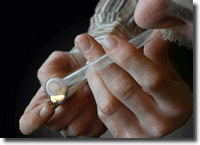About Drug Abuse
- Signs of Drug Abuse
- Causes of Drug Abuse
- Teen Drug Abuse
- Effects of Drug Abuse
- Prescription Drug Abuse
- Facts About Drug Abuse
- Drug Abuse Statistics
- Drug Abuse Counseling
- Drug Abuse Treatment
- Drug Abuse Information
- Preventing Drug Abuse
- Help for Drug Abuse
- Drug Abuse vs Drug Addiction
- Dangers of Drug Abuse
- Drug Abuse Recovery
- Drug Abuse in America

Meth Abuse
 Meth abuse —once only a regional problem of the West and Northwest— has hit Midwestern and Southern States hard and is moving east. Methamphetamine is cheap and easy to manufacture, and profit margins are high. Its powerful stimulant effect has made it more popular than cocaine in many areas. It is a drug that appears to move easily into new areas not typically associated with drug trafficking, where smaller labs serve local groups of users. As a demand or market is established, however, more organized manufacturers and distributors are attracted.
Meth abuse —once only a regional problem of the West and Northwest— has hit Midwestern and Southern States hard and is moving east. Methamphetamine is cheap and easy to manufacture, and profit margins are high. Its powerful stimulant effect has made it more popular than cocaine in many areas. It is a drug that appears to move easily into new areas not typically associated with drug trafficking, where smaller labs serve local groups of users. As a demand or market is established, however, more organized manufacturers and distributors are attracted.
A recent study at the University of Arkansas found that businesses in Benton County (population of about 170,000) were losing an estimated $21 million annually because of meth abuse — costs largely due to absenteeism and lost productivity. Meth dealing and meth-related sales can also seep into the workplace. In June, more than 200 law enforcement agents arrested 49 people at 16 companies associated with convenience stores. They were indicted on charges of knowingly selling products used to make meth. Those involved included employees and owners of convenience stores, a tobacco store, a grocery and others, according to the U.S. Attorney's Office in the Northern District of Georgia.
Available data on meth abuse user’s reveal that most are white, are in their 20’s or 30’s, have a high school education or better, and are employed full- or part-time. Methamphetamine is used by housewives, students, club-goers, truckers, and a growing number of others. Almost as many women as men use meth (55 percent male, 45 percent female.)
But a meth abuse user is not the typical drug user. That is because methamphetamine has acute toxic effects that produce long-term problems for the user and those around him/her. It is a powerful central nervous system stimulant that promotes the release of neurotransmitters that control the brain’s messaging systems for reward and pleasure, sleep, appetite, and mood. However ingested (injected, taken orally, or snorted), meth produces extended highs and potentially agitated or over energized states.
Chronic meth abuse causes long-term alterations to users’ brain chemistry and structure that result in impaired memory, mood alterations, impaired motor coordination, and psychiatric problems, even long after terminating use. The short-term management of the agitated user at arrest and the long-term health problems that jails and lock-ups must deal with make those with a meth abuse problem a serious logistical and financial burden, particularly in areas with limited manpower or resources.
Fifty-eight percent of county law enforcement agencies surveyed by the National Association of Counties in 2005 listed meth abuse as the number one drug problem in their area. States as diverse as Arkansas, Indiana, Vermont, and Wyoming reported increases of more than 90 percent in meth arrests in the prior year. Cheap, easy to manufacture, and long lasting, meth has become more popular than cocaine in some U.S. cities. And the problem is no longer confined to discrete regions of the country.
Unlike imported drugs such as heroin or cocaine, meth is easy to produce domestically. It is synthesized from precursor chemicals using relatively easy production methods that are commonly available on the Internet or in underground publications; anyone with high school chemistry experience can “cook” methamphetamine. Many of the base chemicals are household or farm products that are not feasible to regulate. However, other elements (ephedrine and pseudoephedrine products, and anhydrous ammonia) have come under serious scrutiny, and Federal and State legislation now monitors their sale and limits their availability. Unfortunately, as restrictions effectively close “Mom-and-Pop” operations—also known as small toxic labs or STLs—the demand for meth remains. Law enforcement in many areas reports increased evidence of organized drug traffickers, largely from Mexico, covering the established demand.
Although the number of small “Mom-and-Pop” labs is far greater than the number of superlabs (labs capable of making 10 or more pounds of product at a time), the Drug Enforcement Administration (DEA) states that the bulk of meth on the U.S. market comes from superlabs concentrated in the Central Valley and southern areas of California or in Mexico. Data show that the presence of superlabs in the United States is expanding. Historically, precursor chemicals were smuggled to superlabs in the Southwest and California, but the current distribution is more geographically dispersed throughout the country. DEA’s Clandestine Laboratory Seizure System reports that the number of superlabs seized in the western regions has actually declined by half between 1999 and 2004, but has doubled in the South. And while seizures of meth powder have declined in some areas, officials report an increase in seizures of the higher potency crystalline form not generally made by local “cooks.”
